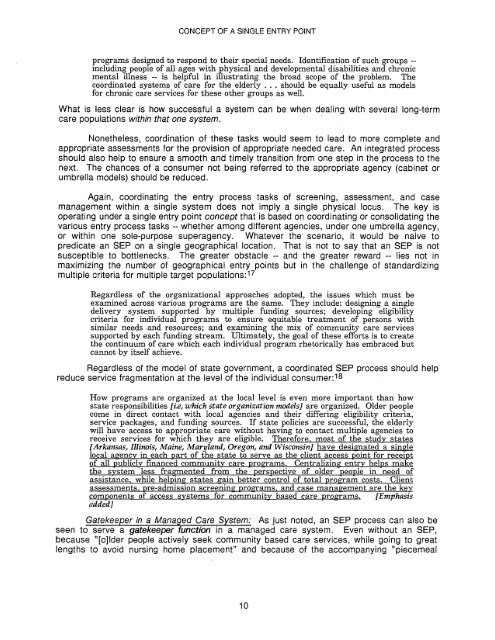long-term care - Legislative Reference Bureau
long-term care - Legislative Reference Bureau
long-term care - Legislative Reference Bureau
You also want an ePaper? Increase the reach of your titles
YUMPU automatically turns print PDFs into web optimized ePapers that Google loves.
CONCEPT OF A SINGLE ENTRY POINT<br />
programs designed to respond to their special needs. Identification of such groups -including<br />
people of all ages with physical and developmental disabilities and chronic<br />
mental illness -- is helpful in illustrating the broad scope of the problem. The<br />
coordinated systems of <strong>care</strong> for the elderly . . . should be equally useful as models<br />
for chronic <strong>care</strong> services for these other groups as well.<br />
What is less clear is how successful a system can be when dealing with several <strong>long</strong>-<strong>term</strong><br />
<strong>care</strong> populations within that one system.<br />
Nonetheless, coordination of these tasks would seem to lead to more complete and<br />
appropriate assessments for the provision of appropriate needed <strong>care</strong>. An integrated process<br />
should also help to ensure a smooth and timely transition from one step in the process to the<br />
next. The chances of a consumer not being referred to the appropriate agency (cabinet or<br />
umbrella models) should be reduced.<br />
Again, coordinating the entry process tasks of screening, assessment, and case<br />
management within a single system does not imply a single physical locus. The key is<br />
operating under a single entry point concept that is based on coordinating or consolidating the<br />
various entry process tasks -- whether among different agencies, under one umbrella agency,<br />
or within one sole-purpose superagency. Whatever the scenario, it would be naive to<br />
predicate an SEP on a single geographical location. That is not to say that an SEP is not<br />
susceptible to bottlenecks. The greater obstacle -- and the greater reward -- lies not in<br />
maximizing the number of geographical entry points but in the challenge of standardizing<br />
multiple criteria for multiple target populations: 17<br />
Regardless of the organizational approaches adopted, the issues which must be<br />
examined across various programs are the same. They include: designing a single<br />
delivery system supported by multiple funding sources; developing eligibility<br />
criteria for individual programs to ensure equitable treatment of persons with<br />
similar needs ·and resources; and examining the mix of community <strong>care</strong> services<br />
supported by each funding stream. Ultimately, the goal of these efforts is to create<br />
the continuum of <strong>care</strong> which each individual program rhetorically has embraced but<br />
cannot by itself achieve.<br />
Regardless of the model of state government, a coordinated SEP process should help<br />
reduce service fragmentation at the level of the individual consumer: 18<br />
How programs are organized at the local level is even more important than how<br />
state responsibilities [i.e, which state organization models] are organized. Older people<br />
come in direct contact with local agencies and their differing eligibility criteria,<br />
service packages, and funding sources. If state policies are successful, the elderly<br />
will have access to appropriate <strong>care</strong> without having to contact multiple agencies to<br />
receive services for which they are eligible. Therefore, most of the study states<br />
[Arkansas, Illinois, Maine, Maryland, Oregon, and Wisconsin] have designated a single<br />
local agency in each part of the state to serve as the client access point for receipt<br />
of all publicly financed community <strong>care</strong> programs. Centralizing entry helps make<br />
the system less fragmented from the perspective of older people in need of<br />
assistance, while helping states gain better control of total program costs. Client<br />
assessments, pre-admission screening programs, and case management are the key<br />
components of access systems for community based <strong>care</strong> programs. [Emphasis<br />
added]<br />
Gatekeeper in a Managed Care System: As just noted, an SEP process can also be<br />
seen to serve a gatekeeper function in a managed <strong>care</strong> system. Even without an SEP,<br />
because "[o]lder people actively seek community based <strong>care</strong> services, while going to great<br />
lengths to avoid nursing home placement" and because of the accompanying "piecemeal<br />
10
















